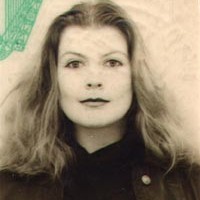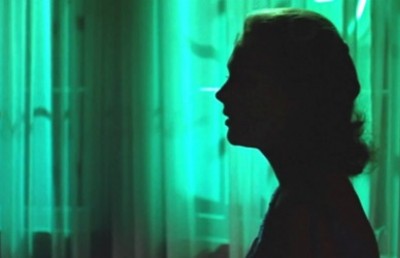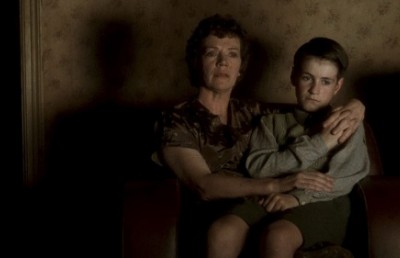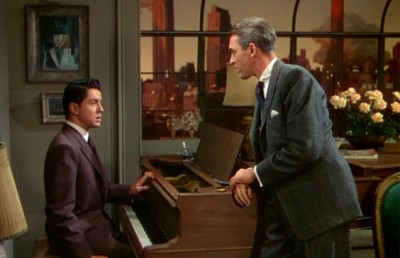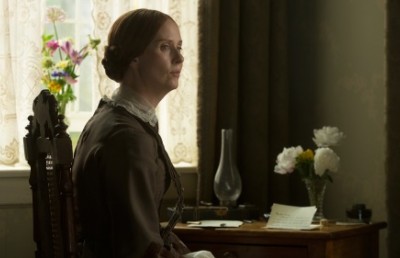Hitchcock Blonde: Scarlett Johansson, Scream Queen!
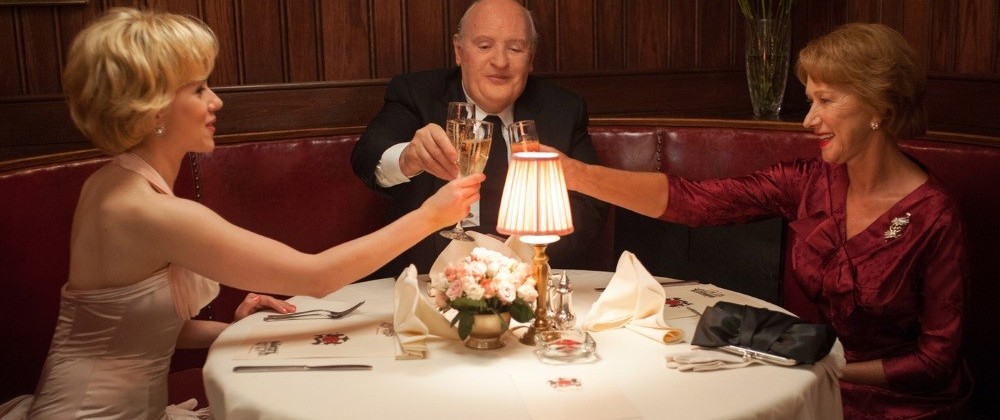
Hitchcock (2012) is a film in quote marks. It probes the idea of cinematic authorship, particularly the notion of auteurism. It is a witty dissection and playful mosaic that vividly and deliciously interrogates Hitchcockian tropes of doubles, dichotomies, parallels and reflections, all within the context of the making of Psycho (1960), a landmark in cinema. The biggest cinematic joke is that the most famous filmmaker in cinema history with a penchant for making sly appearances in passing in his own work, is here the star of the show. His body of work was first properly noted and critically analysed by French critics Eric Rohmer and Claude Chabrol in their landmark 1957 book, Hitchcock: The First Forty-Four Films: they find the guilty woman a central figure in his oeuvre (Rohmer & Chabrol: 1957/1988). Later, Tania Modleski would characterise the devouring mother (Modleski, 1988).
The film chronicles the director’s travails during the instigation, preparation, production and release of what turned out to be his most controversial, famous and lucrative film, Psycho, a censor-baiting pitch for the youth market. Freedman and Millington refer to the film’s Freudian/literary significance as the “creation of a new primal scene for the American Gothic: the motel”(1999: 5). Since October 1955 Hitchcock had been inhabiting every American living room with the success of his weekly TV suspense series, Alfred Hitchcock Presents, in an extraordinarily profitable deal negotiated by agent Lew Wasserman (played here by Michael Stuhlbarg) 1 The director was fast becoming the world’s most recognisable filmmaker by virtue of that and a succession of lucrative publishing deals and he now applied the economy of his weekly TV productions to a feature film he would fund himself. As part of the accompanying pseudo-analysis that followed Spoto’s book screenwriter Joseph Stefano would say of Hitchcock that he,
… had reached a point in his professional life when he was ready for a totally different kind of picture… In his previous films he had told things about himself he thought were true, but in Psycho he told more about himself, in a deeper sense, than he realised. He had been very concerned about his health, and I think he made the picture at the very time he was grappling with his own mortality. After all he had been very ill in 1957, and Alma had been very ill in 1958. And then in 1959 along came this murderous film. I think it was the sudden-death aspect that involved him emotionally.
(Patrick McGilligan, 2003: 590)
For McGilligan,
It was at this stage that Hitchcock really became the embodiment of his image, a man who walked onto the set just as he did at the opening of his television show, moving to fit his India-ink caricature. Everyone accepted common truths about him – even if those truths were superficial.
(Ibid.)
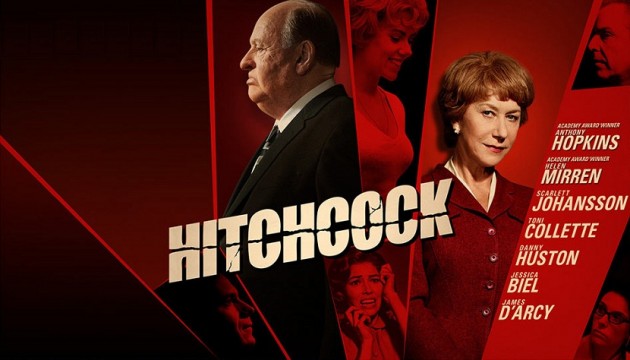
A few years following the release of Psycho Andrew Sarris’s auteurist The American Cinema would designate Hitchcock a Pantheon director, “the supreme technician of the American cinema. Even his many enemies cannot begrudge him that distinction… Hitchcock requires a situation of normality, however dull it may seem on the surface, to emphasize the evil abnormality that lurks beneath the surface. Hitchcock understands, as his detractors do not, the crucial importance of counterpoint in the cinema”(Sarris, 1968, 1996: 57). David Thomson underlines the significance of Psycho to the American psyche:
Most films of the 50s are secret ads for the American way of life. Psycho is a warning about its lies and limits.
(Thomson, 2009: 24-5)
The film’s primary story is the relationship between Hitchcock (Anthony Hopkins) and his wife Alma Reville (Helen Mirren) during a fraught and controversial production. In this auteurist portrait, Janet/Marion is a luminous and occasionally paradoxical corrective to the uneasy ideas promulgated by the controversial biography The Dark Side of Genius: The Life of Alfred Hitchcock by Donald Spoto (1983) which departs from the auteurist hagiographies produced by French critics to suggest that behind this great artist was a psychopathic deviant. He is described as a “sadist”(164) and “emotionally schizoid”(169). This disjunction is the narrative dialectic on which Hitchcock rests. When he brings home a copy of Robert Bloch’s Psycho for Alma’s approval, she observes that it’s horror. And he protests, “Yes, but what if someone really good were to do it?” Thus is the scene set for the transition from suspense to horror and the troubled production of a career-defining film, moves reflected in the story’s construction.
The film also constructs a psychological character portrait behind one of the cinema’s most memorable characters: Marion Crane is the role that made Janet Leigh a screen icon. The treatment she receives in Psycho illustrates not just the duality of Hitchcock’s protagonists, but also the sense and context of stardom itself, its ironic need to draw in an audience on the pretext of an actor’s ordinariness; and the commodification and mythmaking quality of a glamorous and disposable performer, who can be Everywoman and extraordinary, all at once. Janet Leigh is killed off forty-six minutes into the running time. With Marion Crane’s demise in the most intimate of fashions, Hitchcock was reinventing the place of stars in cinema, therefore the casting of Janet/Marion is crucial to the success of Hitchcock as a complex narrative. (The burden of the narrative of Psycho then rests upon the slim shoulders of Norman Bates, played by the unforgettable Anthony Perkins.) In true polysemic Hitchcock style, in Hitchcock Scarlett Johansson plays a dualistic character – Janet Leigh and her role in Psycho. Thus the performing raises an issue of embodiment: how to play an authentic impersonation of a beloved Hollywood star and also to figuratively represent a cinematic icon whose very blankness configured her modernity. In this Hollywood hall of mirrors, we see Janet/Marion in twelve scenes, spread throughout the film as the production occurs. It is essentially a supporting role in an ensemble. As Janet Leigh/Marion Crane in Hitchcock Johansson has to directly channel old-school movie glamour as well as notorious slasher film victim, paradoxically re-enacting a role whose very construction confronts the notion of stardom itself. The director told Francois Truffaut
In the average production, Janet Leigh would have been given the other role. She would have played the sister who’s investigating. It’s rather unusual to kill the star in the first third of the movie. I purposely killed the star so as to make the killing even more unexpected.
(Truffaut, 1983: 269)
The basis for Hitchcock is Stephen Rebello’s 1990 book, Alfred Hitchcock and the Making of Psycho, altered and developed from an essay originally written for Cinefantastique and adapted by John McLaughlin. Director Sacha Gervasi made uncredited additions to the screenplay, along with Ryan Murphy and Rebello himself.
The Hitchcock Blonde
The immediate problem in casting Leigh (and therefore Marion Crane) was the issue of the Hitchcock Blonde, that iconic cinematic figure hyper-semiotised by Grace Kelly but also Madeleine Carroll, Ingrid Bergman and Kim Novak. Molly Haskell describes the phenomenon of the blonde in Hitchcock’s films in which the traditional silent film iconography is reversed:
For Hitchcock… the blonde is reprehensible not because of what she does but because of what she withholds: love, sex, trust. She must be punished, her complacency shattered; and so he submits his heroines to excruciating ordeals, long trips through terror in which they may be raped, violated by birds, killed. The plot itself becomes a mechanism for destroying their icy self-possession, their emotional detachment.
(Haskell, 1973/1987: 349)
Anthony Perkins and Hitchcock also got along very well but for the purposes of Hitchcock it is the representation of the Hitchcock blonde – his perpetual villain/victim – that is so crucial to an understanding of the film’s theme of auteurism which it unpicks, confronts, deflates and encourages, all at once.
Who is Marion Crane?
In this involuted metatext of references, quotes both verbal and visual, gossip, rumour and jokes, the boundaries remain fluid between cinephilia and necrophilia, reaction and reflection, repetition and recognition, the reality of performance was crucial to achieve a cohesive story.
For screenwriter Joseph Stefano she is “an attractive girl nearing the end of her twenties and her rope” (Psycho, revised December 1, 1959: 1). Furthermore, as Pam Cook claims,
Marion, a woman, attempts to cross traditional sexual divisions by becoming active rather than passive, by becoming a thief in order to get what she wants.
(Cook, 1985: 128)
Who is Janet Leigh?
In Molly Haskell’s view Janet Leigh is amongst the “amphibians, women … whom one visualizes in black and white with color around the edges” (Haskell, 1973,1987: 236). She was discovered by Norma Shearer and got a contract at MGM which she described as “a complete city. You could live there” (Basinger, 2007: 13). MGM had a morals clause in their seven-year contract as Jane Ellen Wayne notes: “… ‘the artist agrees to conduct himself with due regard to public convention… he will not do or commit any act or thing that will tend to degrade him in society or bring him into public hatred, contempt, scorn or ridicule, or that will tend to shock, insult or offend the community or ridicule public morals’” (Wayne, 2004: xi). This had a particular meaning for Leigh as she was concealing a brief teenage marriage (she was just fourteen) which haunted her for many years, a liaison that was consummated in an anonymous hotel room and which she describes in her memoir in third person happening to ‘Jeanette Morrison’ as though it were happening to an actress in a scene from a film (Leigh, 1985: 14-15). She became a big star and one half of an extraordinarily famous couple, married to Tony Curtis, who recalled in his autobiography:
There was such incredible publicity about us, all those magazine layouts, about Janet and me as the fabulous, ideal First Couple of Hollywood. There was no bigger pair. Debbie Reynolds and Eddie Fisher could’ve been our maid and butler by comparison. No other husband and wife team came close to us until Richard Burton and Elizabeth Taylor, but that was ten years later. They did it through scandal. We did it through the movies and people’s affection.
(Curtis, 1993: 117)
Jeanine Basinger characterises their fame among,
Examples of those ‘down-home’, we’re just real people’ movie stars. They had kids and posed with baby strollers and diapers while rustling up some eggs in the kitchen. They consciously removed themselves from the hothouse stardom of Lana [Turner] and Ty[rone Power].
(Basinger, 2009: 208)
Leigh was also a very popular and sociable figure who loved the Hollywood scene as Curtis describes:
I resented the way she would insist we go to a party or a film premiere when I’d been working all day on a film and was exhausted at night.
(Curtis, 1993: 200)
They were acquainted with the Hitchcocks through their mutual agent, Lew Wasserman (played here by Michael Stuhlbarg) (Curtis: 196).
Leigh had played the role of woman in jeopardy in Psycho’s fraternal motel twin, Touch of Evil (Welles, 1958) to which Alma (his most trusted advisor) alludes when she pitches her to Hitch. Assistant set designer Robert Clatworthy worked on both films, creating a matrix of allusiveness in mise-en-scène. Richard Armstrong reminds us that
Both feature women who step beyond the codified respectability of their worlds, unconsciously playing to male fantasies about what they are like in the flesh.
(Armstrong, 2004: unpaginated)
For Armstrong, Leigh’s place in the Pantheon of screen acting is not problematic but it is modern:
Janet Leigh has come to embody a potent vision of cinematic modernity. Actors who do this are not great in a theatrical sense … More the vivid brush strokes of affect vivified by the dynamic interaction of presence and absence which only cinema can confer.
(Ibid.)
Who is Scarlett Johansson?
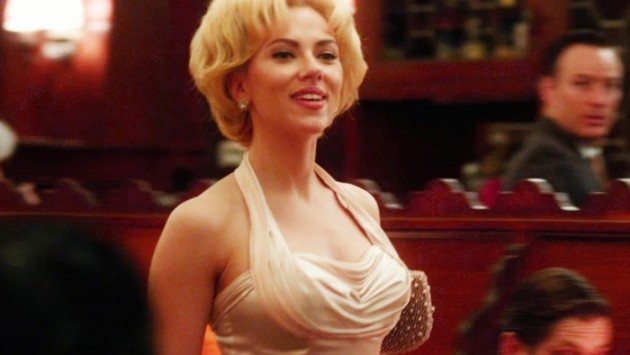
Hitchcock is an example of what Patrick McGilligan reminds us Hitchcock himself called putting “ordinary people in bizarre situations” (McGilligan, 2003: 13) so the actress playing Marion and Janet had to have the qualities of both performer and character.
According to the film’s production notes, “the filmmakers of Hitchcock went after an actress with a rare ability to move from the modern to the classic, Johansson. ‘I’ve never met a woman of her age, who is that self-possessed, articulate, intelligent and understands her own persona,’ says [Sacha] Gervasi of Johansson. (Cinema Review)
Referring to her breakout role in Lost in Translation (Sofia Coppola, 2003), Vanessa Thorpe calls Johansson “this blonde bombshell from New York… Beautiful, mysterious and charismatic: she was already an aspirational trophy for any traditional leading man… her sardonic smirks and sultry looks spoke of old-school movie glamour” (Thorpe, 2017: unpaginated). Johansson was eighteen playing twenty-five and “already, in her late teens, on film Johansson oozed. Soon she was like [Gary] Cooper in Von Sternberg’s Morocco (1930) – slightly behind the beat, in no rush to get her point made and not fretting about being heard at all. What she and von Sternberg could have done together. He’d have slowed her down even more” (Cousins, 2016: 3). Cousins states: “…Johansson was — like Marilyn Monroe— sadder than the scenes in which she appeared, and this, along with her slowness, became her signature” (Ibid.). Historian Jeanine Basinger acknowledges Johansson as “a throwback to a Lana Turner type, but with an edge” (Basinger, 2009: 544n). This suggests the perfect meshing of image and role, as Ellis might put it (Ellis in Butler, 1999: 311-312).
Johansson states she took the role because,
I love these kind of movies. I like the idea of portraying an actor who is amidst the process of finding a character and collaborating with a director and you know that behind the scenes peek. I just think it’s kind of a rare opportunity that a script like that comes along.
(Hitchcock DVD extras)
Amongst other things, impersonating Janet Leigh had the dramatic function of ballast between Hitchcock and Alma:
When we find Hitch and Alma in this stage of their lives we experience you know the kind of valley you know now that they’re up against. How does Alma pull Hitch out of the funk and what does it mean to be two people in the kind of autumn of a relationship and how do you keep that love alive?
(Ibid.)
Hitchcock worked very closely with his leading lady and they enjoyed a very amicable relationship. Janet Leigh’s persona was ladylike, politically engaged and humorous: she made home movies on the weekend with close friend Jerry Lewis, whom David Thomson characterises as “the only other functioning crazy in American film then”(2009: 16). She also enjoyed social status as a famous actress married to a famous actor. She appeared in dramas, thrillers, film noir, musicals, costume dramas and westerns. Johansson similarly appeared to date in costume drama and contemporary drama and was Woody Allen’s latest muse.
While both actresses might be described as buxom, Leigh’s facial features are sharp, her expressions vibrant and inquisitive (we just know her mind is racing), her movements quick. Johansson appears much softer, slower, even blurred, relaxed and sleepy where her predecessor seems edgy. Johansson has a lower centre of gravity and a more languorous affect. It’s hard to picture her ruffled or particularly engaged. In other words their expressivity is of a contrasting variety.
Leigh’s voice is higher, Johansson’s is famously throaty and low with a paradoxically nasal inflection which is presumably attributable in part to her New York City upbringing.
Leigh trained at MGM after being ‘discovered’ by Norma Shearer at a ski resort where her father worked as desk manager. She credits studio coach and former actress Lillian Burns Sidney with her approach to her craft:
From the first time I read a scene with her at MGM … she guided and led me toward an understanding of this profession and my craft. She helped me to recognize holes and weak spots in a script. She showed me how to create the reality of a role, how to make the character mine.
(Leigh, 1995: 60-61)
When she read the book and then the script Leigh recalled:
I really cared about Marion Crane, and that made all the difference. She was shown to us from page one; I knew her.
(Leigh, 1995: 37)
Johansson was enrolled at the Lee Strasberg Institute for Young People where students train in the Method style (an intensive form of personification) and according to Sharon Marie Carnicke,
Method training ultimately teaches that logic’s value lies only in whether it ‘helps the actor to play the scene with an aliveness, with a spontaneity, with a believability both for herself and for us’.
(Carnicke, 1999: 83)
But Method actors also (infamously) “find characters within themselves”(Carnicke: 81). Johansson says of her acting process:
You put a little piece of yourself in every character that you do. I always come back to the fact that my own instinct is better than something I build in my mind.
However she had to find the real Janet Leigh:
She was different in that she was married to Tony Curtis and she had three children, so she didn’t quite fit that category of impossible to reach blonde. She truly was unavailable because she was a wife and a mother and was also a kind of funny, sexy, confident broad who was able to have something more like a friendship with Hitchcock … In the film, their professional relationship is an opportunity to see Hitchcock’s more playful side, the side that was mischievous and childlike.
Referring to the intensity of preparation for performance Johansson told photographer Jean-Paul Goude:
I think it’s just not a natural state to be in, to constantly dig up what stirs and disturbs you and air it all out for everyone to see, so to speak. So the preparation for … a project is like you have to have a huge surgery or something and you’re going to be out of commission for six months. It’s a big pill to swallow. A big, wonderful pill.
(Goude, 2012: unpaginated)
Acting and ReactingThe performing challenge for Johansson lies in locating the commonalities between Janet Leigh and Marion Crane whilst creating a single figure believable to a modern audience within a nostalgic/postmodern text replete with pastiche, quote marks and homages. Simply put, Johansson’s task was to locate the place where pathos meets pathology. That occurs – appropriately – in the shower murder, where intimacy collides with voyeurism in the most horrible fashion in cinema’s most iconic scene, culminating in a freeze frame of Janet Leigh’s eye. The idea posited pace Spoto is that Hitch is Norman Bates or Ed Gein (the inspiration for Bloch’s novel), a psychological trick played on the audience to underpin the crisis at the narrative’s fulcrum as well as addressing the idea that Hitchcock was a misogynist who identified with certain of his screen characters. This is an extreme auteurist position which the surrounding narrative here both combats and endorses, just as Norman Bates’ murderousness is displaced within the text of Psycho by his overtly sympathetic behaviour (and his presumed personal insanity).
Cahiers du cinéma critic Jean Douchet assessed Janet Leigh in the role and thereby presents one performing problem to be addressed by Johansson:
The spectator’s feelings towards Janet [Leigh] are a mixture of envy and contempt. A woman who agrees to visit this seedy hotel room, in mid-afternoon, in her provincial home town, is unworthy of respect. The spectator can therefore attribute to her his own worst motives, including his unconscious desire – which he dare not act on himself – to steal… We dearly want her to get away with it and we’re rooting for her. But that altruistic thought is a cover for our own crime, which it is Janet Leigh’s job to assume on our own behalf.
(Douchet, Nov. 1960 in Krohn, 2010: 78)
Director Gervasi recalls:
Scarlett took it incredibly seriously … She read all the books, she called Jamie Lee Curtis — Janet’s daughter — she got all her facts right, she researched what she wore, what she would be smoking on set, like she knew every biographical detail.
(Waldholz, 2012: unpaginated)
The actress says of Leigh:
From everything I heard and read about her, she was a very grounded, humble woman and a wonderful mom, first and foremost, which I think really informed me.
In Hitchcock, Johansson appears in just a dozen scenes, entering at 27 minutes and exiting at 80 minutes 30 seconds. In total she has under 18 minutes of screen time; Leigh dominates the first 46 minutes of Psycho. According to the film’s production notes there were additional scenes written featuring Leigh, Anthony Perkins and Vera Miles but they didn’t shoot them in the 36-day long schedule which was done on location in Paramount Studios, Red Studios, 20th Century Fox Studios, Glendale, Beverly Hills, downtown Los Angeles, Montrose and Pasadena. The dangers of tipping into camp or parody had to be avoided particularly following the shot-for-shot remake (Van Sant, 1998.)
For Richard Dyer, star performance can be gauged by appearance, gesture, action and speech, using costume, makeup, hair and posture to transform meaning through impersonation (Dyer, 1979/1998: 106-124). This provides a matrix against which Johansson’s affect can be gauged as she creates a role beyond the passivity that playing a cinematic icon could imply.
Johansson’s approach can be analysed fourfold throughout the film:
- As a performance in and of itself (parsing performance)
- As an imitation of Janet Leigh (one star impersonating another in a biography)
- As an imitation of Janet Leigh’s performance as Marion Crane (genre)
- As a performance of Marion Crane, a necrophiliac fetish-object and cinephiliac heroine-victim (homage, personification, training and technique)
The 12 Scenes of Hitchcock:
Johansson has three scenes from the original film to recreate as Marion Crane: the opening lunchtime tryst with Sam Loomis (twice, including the faux attempt to reshoot it with the PCA’s participation on the last official day of shooting); the drive from Phoenix to California; and the shower scene, which is shot from Hitchcock’s perspective. The other scenes are as Janet Leigh: meeting with the Hitchcocks at Chasen’s; taking the oath in the studio with all the cast and crew; discussing the peep-hole and Norman’s motivation with Hitch and Anthony Perkins; chatting with Vera Miles (Jessica Biel) in her dressing room; driving Hitch home in her VW Bug and asking about Vera; giving Alma a bag of candy corn for Hitch as a gesture of thanks; and meeting Mother in her dressing room at the conclusion of shooting. She is costumed for the most part in a limited palette of white, beige and gold, aside from the grey wool shift dress for the drive to Phoenix. This enhances her lustrous image.
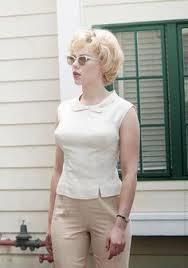
We see Leigh as movie star; off set in civvies; and on set as Marion. Costume designer Julie Weiss explained her approach to dressing the characters:
To have both the world of Alfred and Alma and the world of Ed Gein – that’s a gold mine …I had the opportunity to go from plaid shirts to glamorous gowns. …This was a period of time where grooming was extremely important so there’s a level of finish to all the characters… You start by asking yourself, why does this person get dressed the way they do? The most important thing is that when the actor looks in the mirror, they feel they’ve become that character. That’s what it’s all about.
For Psycho, Hitchcock reportedly told costume supervisor Helen Colvig, “Either they wear the clothes and do the part the way I want, or they’re not going to be in it” (Rebello: 74 ). However he debated whether Marion should be clad in white or black underwear for the opening scene at the hotel and had research carried out among office workers in Phoenix to decide upon the appropriate clothing as well as verisimilitude in living accommodation. And Leigh would be presented in these revealing garments in the film’s unprecedented advertising campaign which Hitchcock was planning prior to the film shoot. We see both colour brassieres in Leigh’s dressing room.
Johansson’s makeup design is a more muted affair than Leigh’s in Psycho – her winged eyebrows aren’t as dark, her lipstick is paler and her hairstyle is softer and larger.
We hear about Janet Leigh before we meet her – a classical Hollywood screenwriting trick. Hitch and Alma are now doing their own gardening to save on household expenses (screenplay pages 33-34).
ALMA
What about Janet Leigh? She’s always the ‘good girl’ but she did awfully well in Touch of Evil. Lew mentioned her name. Do you remember how you always remarked on her figure at the Wassermans’ parties?
(Hitchcock: p. 34)
27’02”-32’59” Dinner at Chasen’s
Janet Leigh enters Chasen’s for dinner with the Hitchcocks on a cheeky cut – literally. Hitch is holding garden shears in the left of frame and the next frame introduces Leigh camera left, on a close-up of her derriere, clad in a bustle accentuating her gold evening gown. She is every inch the star. This accentuates the role of the body in the cinematic text of Psycho (“a preview of coming attractions, “as Grace Kelly said in Rear Window, 1954). It also summons up memories of Marilyn Monroe’s entrance in Some Like it Hot (Wilder, 1959), a scene Monroe herself suggested, accompanied by explosive emissions of steam from the tooting train. It recalls Monroe’s co-star Tony Curtis’ first meeting with the woman whom he would marry and which he recalls in his autobiography:
Let me tell you about the first time I saw Janet Leigh: I walked into a cocktail party at RKO, and there she was… Her face was exquisite – and those beautiful bosoms and tiny waist. It just devastated me to look at this woman. She had an incredible figure.
(Curtis, 1993: 109)
In this doubling text this shot also reminds us of our introduction to Alma Reville in the film’s opening scene, the premiere of North by Northwest. It is a nod to the Freudian theory of anal-compulsion that runs through Psycho (Sterritt, 1993: 100). And it calls up Hitchcock’s own comments about the disposable immediacy of television – laxatives were frequent sponsors of his show. However it also plays into Johansson’s own star text: she is introduced in Lost in Translation with a shot of her derriere, wearing pink panties. This aspect feeds into the film’s own postmodern metatextuality with fluid references from then (1959) and now (2011). Johansson plays Leigh as fully aware of her impact as Hollywood player: she saunters towards the Hitchcock table as the siren she is (her arrival announced by a horn section) but disarms the viewer with her ladylike charm, in keeping with her personable reputation. She takes off her glove in order to shake hands with the director and his wife – a fetishistic action with Freudian connotations that is however barely noticeable so subtly incorporated is this behaviour into her introduction.
Thus we know about her acting skill (Alma told us and we know how much Hitch relies upon her judgment) but she is also an objectified siren who plays up her impact by dressing to impress.
Leigh was a beloved person on the Hollywood scene as her actress daughter Jamie Lee Curtis explains:
My mother… not only carved out a startling film career and family life but she remained a lady while doing so. She entered the lion’s den and tamed the lions and even taught them something about kindness. She brought please and thank you into vogue… when she needed to she could fight with the best of them, but somehow even a right hook was delivered with grace. While so many around her bitched their way through Hollywood, her way was paved with zest, enthusiasm and a joy that is still as abundant as when she started. She always taught me “Do unto others as you would have them do unto you”- and she still applies that philosophy to everything she does.
She is one of the great ladies on the screen and off the screen.
(Leigh, 1984: xi-xii)
We see her dyed blonde hair, much fuller and brighter than the hairdo Leigh sports in Psycho —where the back of Marion’s head (a frequent shot in Hitchcock’s canon) is shown to be naturally dark: Marion literally embodies black and white, Janet is in living colour. She is oddly chipmunk-cheeked and frequently touches her ears which are adorned with gold earrings (Marion puts on earrings on page 2 of the Psycho screenplay, but not onscreen). This is an example of a gesture that Dyer states is a signifier of the personality of the character, but it also links us into Marion’s character, supporting Janet’s perfect casting as it suggests the ‘invisibility’ of the actress in the forthcoming role. It also suggests Johansson’s own perfect casting – this bit of ‘business’ is not in the script and connects us to the film within a film. This role is always reminding us of performance.
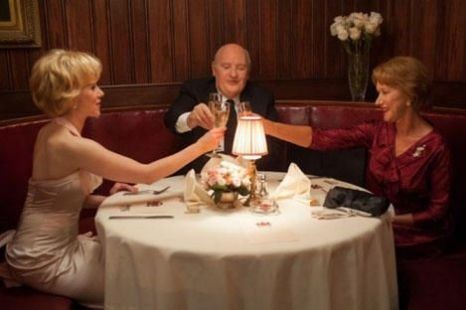
Toasting the film: 20th Century-Fox
After some discussion about dessert prompting Alma’s exit to the Ladies Room, Hitch amuses Janet with a story about the Duke of Windsor and Mrs Simpson:
He’s so deadpan … it takes a moment before she laughs.
(Hitchcock: p.35)
McGilligan points out that on Psycho, Hitchcock’s
presence on the set intimidated many people, and not all the younger folk caught his dry jokes and subtle humor.
(McGilligan, 2003: 591)
Leigh did, and this characterisation of the actress is crucial to creating a more complex and sympathetic portrait of the director in Hitchcock. McGilligan continues
Leigh was a good sport, who got a kick out of the director’s off-color limericks, puns, and pranks… The worst jokes on Leigh seemed to come just moments before her most important scenes – and she found most of them terribly funny.
(McGilligan: 592, 593)
Hitchcock’s popular reputation (“actors are cattle!”) is immediately dispensed with in his enquiry as to how she is preparing for Marion. The following dialogue is slightly amended from the available screenplay with some verbal qualifiers and intensifiers but it exposes Leigh’s own ‘method’:
JANET LEIGH
Well I’ve written an entire history for her, which seems a little silly I know but it really does help.
She turns to pull a LEATHER NOTEBOOK from her handbag
(Hitchcock: 35)
In reality, Leigh says
I invented a complete life for Marion Crane. I knew where she went to school, what church she attended, what kind of a student, daughter, friend, and relative she was.
(Leigh, 1995: 61)
This scene also reminds us of Johansson’s own preparation. Even if, as James Naremore states, it is notoriously difficult to detect much less analyse Method acting in contemporary performance (Naremore, 1988: 197) and the idea of the psychological gesture is probably connected as much with the Chekhov Technique, research is intrinsic to the work of an actor. This exchange demonstrates both Leigh’s seriousness and Hitchcock’s sympathy for acting.
ALFRED HITCHCOCK
It doesn’t sound silly at all. Tell me one of her deepest secrets.
A quick look to Alma, as if to ask for permission before:
JANET LEIGH
She leads a double life. For instance, when she works at the Lowery office, she wears Tweed perfume. But, when she and Sam are together, she recklessly breaks
out her one expensive bottle – “My Sin“by Lanvin.
(Hitchcock: 36)
We observe in that ‘quick look’ that she is attuned to the personal difficulties being telegraphed by Alma. Janet dips her head and declares that she is “first and foremost a wife and mother,” a line inspired by Leigh’s own book about Psycho (Leigh, 1995: 65). Johansson’s understanding of the relationship between Hitch and Alma informed her playing of this scene:
I think Alma has had enough of her husband putting his gorgeous leading ladies on a pedestal, and along with her own feelings of being ignored or undesired by him, that makes her react … But she’s not reacting to Janet so much as to the feeling that this is the last straw and I’m not going to take it anymore. She believed in her husband’s vision, but she also supported his vision and inspired him as a partner in every way. Their artistic collaboration became a kind of unbreakable foundation … I love that Hitchcock becomes a story about two artists in the autumn of their lives – and how they keep that love alive.
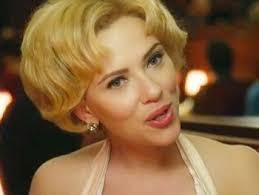
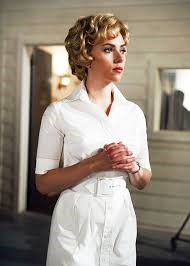
Acting along the axis: shoulders, ears, chin
Her bare shoulders and upper arms provide a constant frame for the reverse shots. The shoulders frequently provide the acting axis for this character’s physicalization in tight frames – we first see Marion in Psycho in bra and half-slip in the motel framed in this way. We see Janet/Marion in the car on the drive to Phoenix in the film; then off set on the drive to Hitch’s home at Bellagio Road; and in the shower in Psycho. The tilt of her head and the inclining of her chin (a pose Leigh adopts throughout Psycho) combine to create a rhetoric of empathetic inquiry. Johansson repeats this limited lexicon throughout the film and compensates for her facial dissimilarity to Janet/Marion by incorporating vividly expressive movements to suggest both amusement and terror in this modern study of alienation. Armstrong reminds us that
In her short tenure on screen, Leigh’s face runs the gamut from contented to perplexed, sad to sympathetic, worried to agonized. It is the expressive lexicon of a million working girls as they negotiate the troubled terrain of contemporary sex and manners, the life (and death) of the American Girl.
(Armstrong, Ibid.)
33’00”– 34’25” Scene sequence: the studio
Janet Leigh is a star and when Hitch knocks on her dressing room door that symbol is the first thing we see. She is clad in Marion’s white shirt and skirt and she crosses her arms – this is a gesture that could mean several things. Perhaps she means business. She might be weaponising herself against the voyeuristic fate that awaits her character. She might be preparing to make a difficult decision. As a psychological action it effectively plays into the multi-referential text. She is preparing for the most difficult role of her life and it is emotionally and dramatically logical that she defend herself. However her light manner of speaking contradicts these interpretations – it is in fact a gesture directly lifted from Marion in Psycho as she crosses her arms when she agrees to have supper with Norman standing outside cabin No. 1. This is another way in which Johansson’s performative choices create continuity across the two roles.
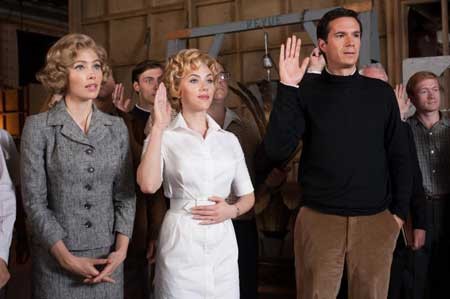
Leigh also clasps her hands (above) in a pose that borrows direct from Leigh as Marion in the office scene; Marion also holds her handbag (containing the stolen $40,000) close to her bosom in several scenes in Psycho. These are actions straight out of the Delsarte code of melodramatic acting but they are also dramatically true for Janet’s preparation.
Carnicke corrects the popular misconception about Lee Strasberg’s interpretation of the Method – she avers that he considered directorial approval essential:
At the Actors Studio, Strasberg explicitly insisted on the authority of the director.
(Carnicke, 1999: 78)
Janet asks Hitch if she looks the part and he removes invisible lint from her collar. Obviously she is perfect.
Just as Marion unconsciously goads Norman in Psycho, Janet goads Scarlett into producing an imagined version of her performance and her essential self, at least in terms of how she responds to Hitchcock. One example is the physical mirroring of Hitchcock’s actions on the studio floor where the oath is sworn: Johansson mimics the director when he places the palm of his right hand on his abdomen by doing precisely the same (and we see from the crane shot and the various two- and three-shots that she is the only member of cast and crew to do so). This prefigures her working relationship throughout production – they like each other and this offers a contrast to the dynamic with Vera Miles (Jessica Biel) whose broken relationship with the director is described by Spoto (2008: 153-55).
Asked whether her character’s abrupt departure from the script bothered her Leigh said:
It never occurred to me that that would be a problem. It didn’t even enter my head. The whole thing that I concentrated on was one, working for Mr Hitchcock, and two, the anticipation of it, what was he going to do with this? I couldn’t wait to see how he would solve this and weave his magic spell and get this project to the public.
(The Making of Psycho, TCM)
Mirroring non-verbal behaviour is thought to establish rapport and facilitate empathy. It is clear that Janet is sympathetic to Hitch and that it is mutual. Her actions underline this and separate her from the sceptical Vera: this mirroring action is not indicated in the script, another instance of ‘business’ created by Johansson to create a consistently sympathetic character and connect Leigh with Marion. Hitch and Janet are connected – which is why the later break in the shower scene has such a devastating impact.
35’58”-37’04” “Here we are – Norman’s inner sanctum”
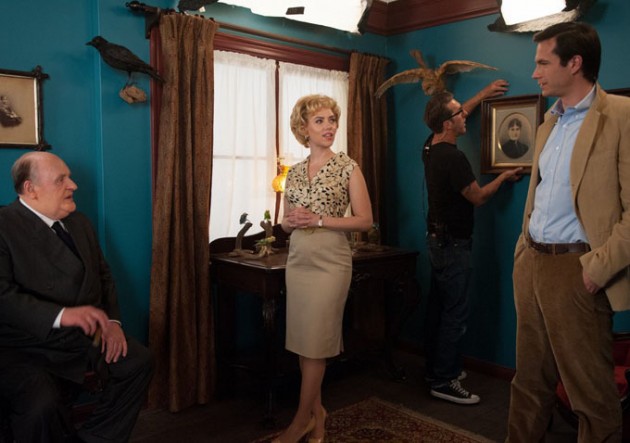
Hitch with “America’s favourite boy and girl next door”
As Hitch leads Tony and Janet across the studio floor into Norman’s parlour Janet has her script clutched to her body and watches as Tony Perkins looks through the peep hole and asks Hitch about his motivation:
JANET
I feel like I should take offense at that!
(Hitchcock: 45)
Johansson is in two angles of medium long shot and she contributes to the discussion, sneaking a stealthy grin at Hitch,
… A boy’s first glimpse of a naked woman is usually his mother.
(Ibid.)
She then switches places with Tony to look through the peep hole: we see her from behind in medium long shot again, her hands on her hips. As Christine Gledhill reminds us, “stars are produced via mechanisms of fetishism and voyeurism” (Gledhill, 1991: xv).
JANET
Hitch, I have a question. Why is the hole so much larger on this side?
ALFRED HITCHCOCK
All the better to see you with, my dear, from the greatest possible angle.
(Hitchcock: 46)
Marion turns to him and she and Tony look at him as the voice carries over to the next scene, replaying the fourth shot in the opening scene of Psycho:
37’05”-37’30” Marion’s lunchtime tryst
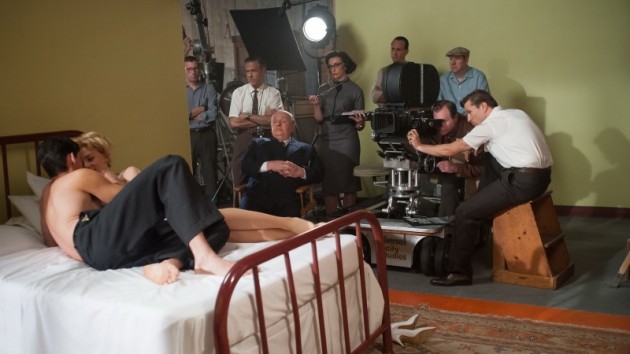
The camera tracks through a window frame into the hotel room where Marion is enjoying her nooner with lover Sam Loomis (Josh Yeo). Shot wide, there is no detail and no dialogue as they are locked in an embrace and the camera reveals Hitch and assistant Peggy Robertson (Toni Colette) a few feet away. Then Hitchcock declares “Cut”.
41’34”-42’44“The drive from Phoenix to California
As Alma lies asleep, eyes covered, Hitch’s voice is carried over onto a shot of Janet Leigh as Marion driving into the state of California, tormented by the imagined reactions of everyone in her life following her theft and disappearance:
ALFRED HITCHCOCK
You think you can get away with it but you can’t…
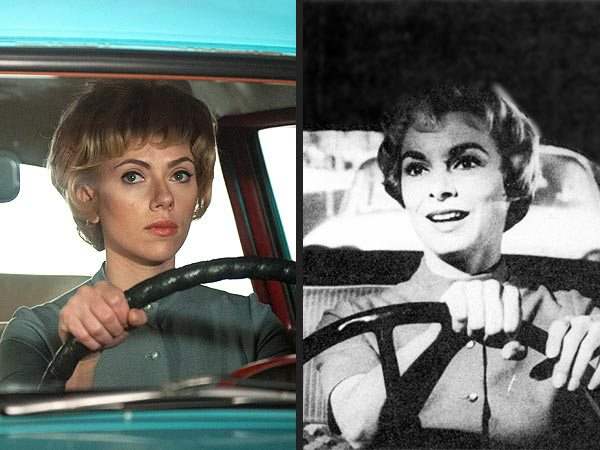
Scarlett and Janet in the driving seat www.people.com
Hitchcock is definitely off script:
Even your boss, strait-laced, hatchet-faced Mr George Lowery, why even he can smell the rancid, pungent scent of sex all over you…
(Hitchcock: 54)
Hitchcock liked Leigh and the feeling was mutual. Directing such personalised guidance from the shot’s sidelines indicated his own feelings about a role that would guarantee her immortality. She states:
[He] explained to me how his camera was absolute and that as a director he had confidence that I would bring to Marion what it needed. If I had any problems by all means he would be there to help me if I should need it. He said, The only sort of control is that my camera has to be the focal point. In other words, when my camera moves, you have to move. If you have a problem with that I can help you with the motivation to move on that point.
(The Making of Psycho, TCM)
Hitchcock said to Truffaut
The more we go into the details of the girl’s journey, the more the audience becomes absorbed in her flight.
(Truffaut,1983: 269)
These lines however are not what Stefano wrote and the screenplay states:
SUDDENLY THE REAR SCREEN film breaks and a frame burns.
It’s a good thing because Janet is starting to look a little uncomfortable — was that meant to be funny?
(Hitchcock: 54)
This is where breaking the expressive coherence is inbuilt and Johansson’s Janet is sitting behind the wheel, looking around her, puzzled (whereas in Psycho Leigh has a furrowed brow, Johansson’s reactions do not match that intensity). (See Naremore on the idea of expressive coherence: 68-93).
For Leigh, Marion is unfortunate:
She’s a very bad thief. I mean she’s clumsy, she obviously can’t disguise what she’s feeling. I mean, she’s so obvious because she’s not practised. So this is not her nature but it’s a grasp, it’s a desperate grasp at life. The only satisfaction almost was on the ride she imagined what they were saying back home … All of that dialogue that she imagines, Mr Hitchcock knew exactly the timing, he knew what lines he was going to use, voiceover. So he did them. He said to me the lines that I was imagining hearing. And so as he was saying it I could imagine just what was being said which was kind of fun thinking, Oh, that creepy guy who had the money anyway, he deserves not to have it. That’s the only sort of pleasurable moment she had really until she meets someone who’s more mixed up and more confused than she. And she was able to realise she can’t go that route either.
(The Making of Psycho, TCM)
Hitchcock’s shouted directions may not be the lines written by Joseph Stefano but what he says appears to explain his perspective and creates further catalyst for her reactions. However Leigh’s own guilty secret may have been motivation enough (Leigh, 1985:15).
42’45”– 43’59” The Hitchcock Blondes
As Janet relaxes and smokes in her dressing room there’s a knock at the door and Vera Miles enters with a little pick-me-up. Janet’s flared skirt is tightly belted and Johansson’s quick movements conceal the unflattering fit.
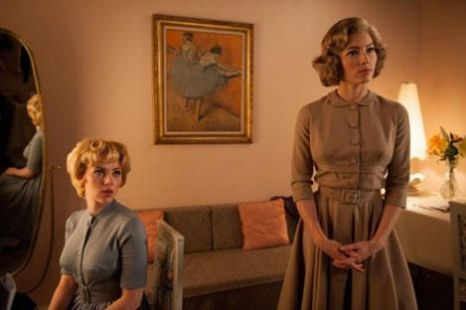
Janet and Vera bond behind the scenes (20th Century Fox)
In terms of her on-screen relationship with Hitchcock, Johansson had done her research into his attitudes to other actresses:
In the case of Psycho he cast Vera Miles as a really dowdy kind of a character when she was really supposed to be his leading lady. And when she decided to get pregnant and have a family, he never called her again. It seems that he held it against her forever. Fortunately my character never fell into that trap. And if Janet always stressed that she had a fabulous relationship with Hitchcock, it’s partly because there was no threat of this sort of situation happening again. They were able to have fun, a sort of flirtatious-platonic relationship.
(Goude, 2012: unpaginated)
Janet attends to her coiffure and manicure at the makeup mirror as Vera explains his predilections – from her perspective.
The reaction to Vera’s inquisitiveness about the director’s involvement in Janet’s personal life elicits the same inclined head, eyes raised, to suggest intimacy and accord and to infer shared professional attitudes and connection.
McGilligan says that Hitchcock said of Vera Mile in later years, “I couldn’t get the rhythm going with her again” (McGilligan, 2003: 547). As the women are talking Hitch’s familiar silhouette materialises and Vera hisses, “See? He’s always watching.”
47’43”-50’01” Where’s your driver?
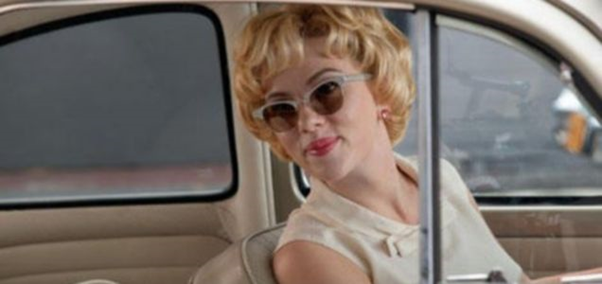
Offering Hitch a lift (Image 20th Century Fox)
Marion Crane is a woman larcenous with desire. This translates into an action which Janet carries out when she is giving Hitch a ride home after Alma’s lunchtime with Whit leaves him alone and helpless at the studio door. The sliding of certain aspects of Marion’s character into Janet’s behaviour assists Johansson’s expressive coherence, joining the dots between Janet and Marion and explaining why Leigh is the ideal actress to play the ultimate Hitchcock Blonde. Playing Janet as a kind, empathetic persona increases our sympathy for her playing of Marion. Her mirroring actions increase our understanding of her function in the narrative – creating a range of empathetic reactions to Hitch and his personal psychodrama as he tackles this enormously problematic film. Johansson uses a sing-song lilt when speaking to Hitch in her VW Bug, an echo of the lone drive from Phoenix in Psycho and a play on the theoretical issue of the performance frame separating film from reality. It is also a good visual joke to put the rotund director in this tiny car. Janet is behind the wheel but Hitch is not in control offset. She offers him candy corn, a conduit to the text of Psycho itself: “I nicked them from Tony’s dressing room!” she trills. For voice coach Barbara Houseman a higher voice is more resonant, committed, vital and “more alert, committed and present” than a low voice (Houseman, 2002: 168). Munching candy is a childish habit and it was Perkins’ idea to use it as an expressive object to establish sympathy for Norman (McGilligan, 2003: 591). The fact that Janet has stolen the candy also links her with Marion. To bring a playful spirit to her she expands her pitch to accommodate the vivid cheer of Leigh’s character with this paralinguistic trope. This insinuates the director into a comfort zone – and she uses the situation to discombobulate him by asking what really happened with Vera. Along with lowering her pitch, she also slows her tempo. She asks him in a concerned register, “What really did happen with you and Vera?” This is clever writing and performing: Janet is in the driving seat and she is authoring the action using her skills as an actress. However she exhibits true compassion for Vera and Hitch when he describes what happened with Vertigo.
In repose here Johansson resembles Marilyn Monroe more than Leigh but the relaxing of her features and the orange-red lipstick softening her mouth makes her a deeply empathetic interlocutor.
When he asks mournfully, “Why do they do it? Why do they always betray me?” the camera is on him but Johansson’s over the shoulder reaction reveals even in this medium close up profile (she is in the right of frame) that she swallows a lump in her throat in sympathy.
In reality this incident never occurred: it was Joseph Stefano who found Hitchcock without his regular ride home one day. But it provides a good parallel with the driving scene in Psycho and utilises the confined situation, the frame, the journey, the candy corn and the dual role of Janet/Marion to expose Hitch’s inner drama and matters of conscience (and respectful friendship).
55’49”-57’24” Murder by montage
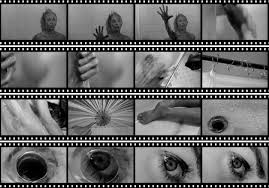
Fragments; the shower scene
One of the issues with screen acting is the fragmenting of performance – and the shower scene in Psycho literally tears the actress into pieces, stabbing at her until she dies. Thomson states:
You can hardly consider the first section of Psycho as anything other than an exploration of voyeurism – the building of sexual excitement through watching.
Thus, it’s important to see that what happens – the shower murder – is both stunningly unexpected and a logical release of the pressures built up in the long, sustained overture. Orgasm at last.
That explosion takes the form of removing our most beloved character and the apparent star of the film in one frenzy of violence – perhaps the most violent passage until then in American film. There’s no doubt that Hitchcock was intrigued by that drastic authority. It was a way of saying that his design was more important than film’s commercial habits or structure.
(Thomson, 2009: 53-54)
The shower murder in Hitchcock was shot over the course of one day, and is staged from Hitch’s perspective, whereas the original was done in seven filming days. The director’s behaviour in Hitchcock could be described as pathological. (Nothing like this happened during the filming of Psycho). For the purposes of voyeuristic identification we might term it a reaction to Leigh’s spectacular figure literally spilling over the limitation of performance causing Hitchcock to become the spectator, unable to control his desire —which similarly translates into an instance of excess (Mulvey, 1975: unpaginated). It is shot literally through the male gaze – Marion becomes the personification of Hitch’s tormentors, imagined and real. This of course plays into the Spoto analysis but produces both heightened fears for Janet – terrified, all but naked, soaked to the (mole)skin – and it serves as crude Freudian shorthand to characterise an enigmatic director whose descent into roleplay proves so entertaining.

“Each editing cut is a slice of the knife!” Janet Leigh speaking on Reputations
The idea of a performance within a performance is tested here and this is where the slippage between ‘Janet’ and ‘Marion’ occurs in more sustained fashion when Hitchcock takes over as the inadequate Mother double to stab at Marion – who from his perspective becomes in turn censor Geoffrey Shurlock (Kurtwood Smith), Paramount boss Barney Balaban (Richard Portnow) and Whitfield Cook (Danny Huston) with Alma. This question of authorship is raised thus: is the controlling director at the behest of his own demons, an inner anguish made actual? Is it Janet’s reaction that curbs his sadistic excess? Or —is it Marion’s reaction? It is entirely appropriate that in this Ur-scene of cinematic voyeurism the dramatic and emotional highpoint of the film’s discourse be realised in conflicted, contradictory style. It is a setup that asks all sorts of questions about the viewer.
Anatomizing Performance
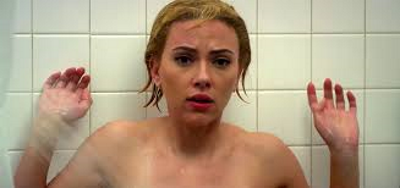
Physicalizing within the frame along the shoulder axis

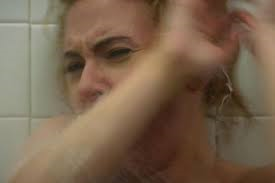
Acting and reacting: Scarlett? Or Janet? Or Marion?
When Johansson screams and throws her hands up are we watching a break in expressive coherence? Are we watching Johansson’s reaction to Hopkins? Leigh’s reaction to Hitchcock? Mother? Or Marion’s reaction to Mother? Or a combination of the three? This is the double remove at which Johansson locates her performance, complicating and layering a multifaceted narrative. These reactions are shot through with shock and incomprehension in a scene whose construction violates personal space. The simultaneous subversion and confirmation of a male spectator in a voyeuristic text produces divided reactions in the viewer – infinite tenderness towards Janet/Marion, but also sympathy for the troubled director losing control amid this ironic (and fictitious) presentation of Hitchcock-auteur: plagued by the devilish Ed Gein whispering him sweet nothings on the imaginary psychiatrist’s couch, far from in control of his emotions, the audience the last thing on his mind. Apart from fragmenting Leigh’s performance his actions in slashing at her also remind us of that
cinematic technology significantly redefines the relationship between director and actor from one of collaboration to one of authority and control… film repositions the director as the primary creator of performance.
(Carnicke, 1999: 76).
In summary, this is the crucible of the film’s emotional text and structural discourse because it exploits the issue of authorship of performance. It is a cunning play on the notion of identification in cinema and serves to simultaneously play up and deconstruct the notion of auteurism, with a director under pressure who finds himself the object of the look – and gives himself away. This reminds us that in Hitchcockiana we are never far from the idea of unfixed identities. It also serves to remind us that the dramatic function of Johansson’s role goes beyond embodying the idea of figural excess to humanise an enigma whose reputation has taken a posthumous bashing.
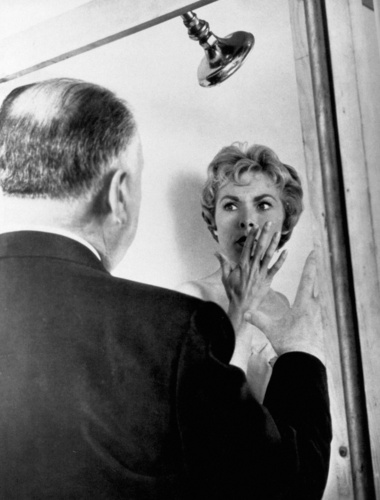
Hitchcock directing Leigh
As McGilligan reminds us, virtually all of Hitchcock’s most celebrated scenes are silent or might as well be, save for the occasional use of natural sound or occasionally music (McGillligan, 2003: 107). Here, we are presented exclusively with Johansson’s actions and screams. The portrayal of Marion is conflated with Tippi Hedren’s account of her treatment in The Birds – Hitchcock himself takes over the slashing, he sees Alma embraced by Whit and slashes harder, with Johansson as Janet/Marion reacting with confused terror: the confluence of all Hitch’s obsessions are in those cuts. This is why the pivot of the film’s drama must occur here: who is in control of this film? This ‘break’ in both characters is consistent with the narrative’s internal integrity.
Asked by Jean-Paul Goude how she prepared for this particularly iconic scene, Johansson responded
I just prepared myself to get very, very wet…she says with a glimmer in her eye! We only had the luxury to shoot the scene for a day, and everybody was feeling very nervous because it involved water and nobody wants the actor to get wet. They were concerned with modesty and all these things—but I don’t care about any of that stuff and Janet Leigh never did either. You have got to be brave, get into the shower, and face Anthony Hopkins as Hitchcock jabbing you in the face with a 12-inch kitchen knife, you know—
(Goude, as before)
She continued:
Maybe I watched Silence of the Lambs too many times when I was a kid. Maybe I was having some flashbacks. So I didn’t need too much preparation for the scene.
As the costumier accompanies “the shaken and exhausted” Janet off set they pass Vera and the script precisely delineates Janet’s expression:
… Janet gives her a look as if to say ‘Now I understand.’
(Hitchcock: 71)
62’42”-63’19” Peace offering
At the conclusion of the day’s shooting when Hitchcock is home dealing with illness and Alma replaces him on set, Janet approaches her at the studio door and presents her with a bag of candy corn, rushing over towards her wearing a black pencil skirt and a blouse with upturned collar which draws attention to her face. She moves quickly, her posture altered by stiletto heels, propelling her forward so that she attains more animation than her usual leisurely gait suggests. She physically expresses her empathy for Alma by inclining her head at the precise angle of the older woman’s: the tilting of her head is an imitative gesture of understanding and one that Alma quickly acknowledges, thanking the actress for her professionalism. It is another instance of mirroring and is a repetition of the action during their scene at Chasen’s. This action and Alma’s words reaffirm that Janet is a consummate professional.
Janet is using the candy corn as a peace offering in another instance of the expressive object utilised across the film and the film within the film. Janet feels the pressure the couple is under (they are financing the production themselves) and this act of solidarity is emphatic in its insistence on her innate kindness and personal warmth toward both the Hitchcocks. This actuates the sense that she has a supporting role in the wider narrative that is unfolding. (The effect and influence of Psycho will always precede it.) The tight circumference of the dual role’s construction – Janet’s ladylike character, Marion the Everywoman – is symbolised by this simple act.
79’15”- 80’30 Movie queen
Janet and John Gavin are on the hotel bed once again awaiting the direction to reshoot the film’s opening scene for the benefit of Geoffrey Shurlock – who doesn’t turn up. This is the reprise of the film’s opening scene which the PCA demanded be reshot because it was “entirely too passionate” and which script supervisor Marshall Schlom told Stephen Rebello
bq…. [the PCA officials] never showed up, so we never [reshot the opening sequence]. And they finally agreed they didn’t see the nudity in the shower sequence which, of course, was there all the time.
(Rebello,1990/2013: 146)
During the shooting of Psycho, Hitchcock put several different Mother maquettes in Leigh’s dressing room to judge her reaction to assist him in his final choice for the shoot: that story is used just once in the final scene for Leigh as a fun parting shot.
I would come back from lunch and I’d go into my dressing room on the set and the makeup chair – I’d go to get ready after lunch, touched up, and you know I’d turn it around and there would be this hideous monstrosity called Mother! I joke all the time. I think he chose Mother by the loudness of my scream because it was a different one all the time and the one that elicited the most horrifying scream was the one used.
(The Making of Psycho)
After she screams – an appropriate vocalisation for a scream queen– Janet reacts with customary good humour and inclined head – and closes the door on Hitch, on the shoot, and on her role. The shot closes on the star symbol, foreshadowing her cinematic immortality. It also confirms that this has been a performance about stardom, performativity and all the acting resources an actor can bring to a role.
Conclusion: The Actor as Auteur
As Janet Leigh in Hitchcock (2012) Scarlett Johansson is part of an ensemble adopting a biographical performance approach to the dualistic part of Janet and Marion Crane in a playfully complex text that radically engages with issues of cinematic authorship in which the action is framed through the male gaze. The film is both homage and wry interrogation, teasing the audience about the parallels between the legendary director and his film characters and the extent to which his preparation might overwhelm his personality. It investigates the way in which he related to his leading ladies, a subject of some speculation in many books commencing with Donald Spoto’s 1983 biography.
Scarlett Johansson refines the range of her performativity to a limited range of gestures to play Janet and the ultimate Hitchcock Blonde in seamless fashion, crafting a whole performance from a supporting role. She is paying tribute to a film which Spoto calls “a series of our own schizoid feelings” (Spoto, 1976/1992: 320). It is a performance within a performance whose discourse is created within the wider meta-fiction of Hitchcock’s legend. Her dramatic function is to add ballast and sympathy to the central narrative problem, deploying an elegant rhetorical shorthand to convey the authentic Janet Leigh – a professional actress and headlining star, but first and foremost a wife mother, and understanding friend. Johansson deconstructs Leigh’s performance as Marion Crane to find tenets of connectivity between the actress and the role of Marion. She uses a range of acting tools to establish a coherence between Janet and Marion, a tactic that increases our sympathy when she is victimised by Hitch’s directions but which paradoxically serves to enhance sympathy for the director himself who is coaxing her to produce the performance of a lifetime. . She coherently expresses the authentic Leigh and the iconic character through a combination of impersonation and personification. Her limited lexicon, paradoxically drawing on several acting traditions, is a strategy that reinforces the significance of her casting and the impact of her part in this psychodrama, creating fluid movement for her role as actress and character across a text which stresses performativity. By exceeding the demands of the film’s premise and locating those intersections of pathos and pathology that connect Janet with Marion, Johansson expands her performance beyond the limits of the text to establish her authorship of the role. It brings us back to the woman who originated the role – Janet Leigh, an iconic actress whose professionalism enabled her to easily cross the porous borders of classical genres, something that Johansson does in contemporary Hollywood.
Hitchcock reframes notions of the director-auteur by stretching the terms in which we read the eponymous director into his films and characters, layering ideas and direct quotes into a knowing textual assemblage that also reframes questions of authorship of performance. It reinvents the experiences of Janet Leigh in an infamous production which exhibits a unique moral intelligence beneath the blackly comic horror. Ultimately, the dual role of Janet Leigh and Marion Crane makes Scarlett Johansson a modern scream queen.
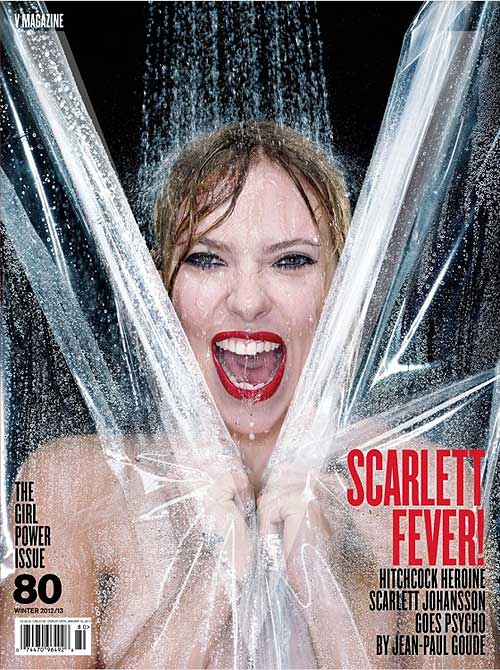
Recreating Marion Crane for Jean-Paul Goude and V Magazine
Alfred Hitchcock and the Making of Psycho by John McLaughlin. Undated screenplay. (There were uncredited revisions by Sacha Gervasi, Ryan Murphy and Stephen Rebello). Referred to as ‘screenplay’ in text.
Hitchcock (2012) production notes: Production Notes
Hitchcock DVD (20th Century Fox Home Entertainment)
Select BibliographyBooks
Basinger, Jeanine. The Star Machine. New York: Vintage Books, 2009
Bloch, Robert. Psycho. London: Robert Hale, 1959/2013.
Butler, Jeremy G., ed. Star Texts: Image and Performance in Film and Television. Detroit, Michigan: Wayne University Press, 1991.
Cook, Pam, ed. The Cinema Book. London: BFI, 1985.
Curtis, Tony and Barry Paris. The Autobiography. London: Heinemann, 1993.
Dyer, Richard. Stars. London: British Film Institute, 1979/1998.
Ellis, John. Visible Fictions: Cinema, Television, Video. London: Routledge & Kegan Paul, 1982.
Freedman, Jonathan and Richard Millington, eds. Hitchcock’s America. New York/Oxford: Oxford University Press, 1999.
Gledhill, Christine, ed. Stardom: Industry of Desire. London and New York: Routledge.
Haskell, Molly. From Reverence to Rape: The Treatment of Women in the Movies. Second Edition. Chicago: The University of Chicago Press, 1973/1987.
Heath, Stephen. Questions of Cinema. London: Macmillan, 1981.
Hirsch, Foster. Acting Hollywood Style: With Photographs from the Kobal Collection. New York: Harry N. Abrams Inc. Publishers, 1991.
Houseman, Barbara. Finding Your Voice: A Step-by-Step Guide for Actors. London: Nick Hern Books, 2002.
Krohn, Bill. Alfred Hitchcock. Masters of Cinema. Paris: Cahiers du Cinéma, 2010.
Leigh, Janet. There Really Was a Hollywood. New York: Jove Books, 1984.
________ with Christopher Nickens. Psycho: Behind the Scenes of the Classic Thriller. London: Pavilion Books, 1995.
Lovell, Alan and Peter Krämer, eds. Screen Acting. London: Routledge, 1999.
McDougal, Dennis. The Last Mogul: Lew Wasserman, MCA and the Hidden History of Hollywood. New York: Crown Publications, 1998.
________ . Alfred Hitchcock: A Life in Darkness and Light. London: John Wiley and Sons, 2003
Modleski, Tania. The Women Who Knew Too Much: Hitchcock and Feminist Theory. London: Routledge, 1988
Naremore, James. Acting in the Cinema. Berkeley and Los Angeles: University of California Press, 1988.
Rebello, Stephen. Alfred Hitchcock & The Making of Psycho. London: Marion Boyars, 1990/2013.
Rohmer, Eric and Claude Chabrol. Hitchcock: The First Forty-Four Films. New York: Frederick Ungar, 1957/1986.
Rothman, William. Hitchcock: The Murderous Gaze (SUNY Series, Horizons of Cinema). New York: State University of New York Press, 2012.
Sarris, Andrew. The American Cinema. New York: Da Capo Press, 1968/1996.
Schuman, Michael A. Scarlett Johansson: Hollywood Superstar. New York: Enslow Publishers, 2011.
Spoto, Donald. Alfred Hitchcock: The Dark Side of Genius. New York: Ballantine Books, 1983
________ . The Art of Alfred Hitchcock: Fifty Years of His Motion Pictures (Revised edition). New York: Doubleday, 1987/1992.
________ . Spellbound by Beauty: Hitchcock and his Leading Ladies. London: Hutchinson, 2008.
Sterritt, David. The Films of Alfred Hitchcock (Cambridge Film Classics). Cambridge: Cambridge University Press, 1993.
Thomson, David. The Moment of Psycho: How Alfred Hitchcock Taught America to Love Murder. Philadelphia: Basic Books, 2009.
Truffaut, François. Hitchcock. Revised Edition. New York: Simon and Schuster, 1983.
Wayne, Jane Ellen. The Golden Girls of MGM: Glamour and Grief. London: Robson Books, 2004.
Articles, Essays & Journals
Armstrong, Richard (2004), ‘ Modernity and the Maniac: The Fall of Janet Leigh,’ Images Journal, Accessed 15 March 2017.
Calendo, John (2008), ‘Alfred Hitchcock at the Drag Ball: When Being Blonde and Soulless is Not Enough,’ Bright Lights Film Journal, Issue 62, November 2008. Accessed 24 October 2013.
Carnicke, Sharon Marie, ‘Lee Strasberg’s Paradox of the Actor,’ in Lovell and Krȁmer: 75-87.
Corliss, Richard, ‘Was Hitchcock Psycho? Alfred Hitchcock: genius or monster, or both?’ Time, 25 November 2012. Accessed 15 March 2017.
Cousins, Mark. ‘A Study in Scarlett,’ Sight & Sound, Vol.26, No. 10, October 2016: 15.
Ellis, John, “Stars as a Cinematic Phenomenon,“in Butler, 1991: 300-315.
Gledhill, Christine, ‘Signs of Melodrama,’ in Gledhill, 1991: 207-229.
Goude, Jean-Paul (2012). ‘Hitchcock Heroine,’ V Magazine, 07 November 2012. Accessed 15 March 2017.
Jones, Oliver, ‘Scarlett Johansson and Jessica Biel Star in Hitchcock,’ People, updated 23 September 2016. Accessed 15 March 2017.
King, Barry. ‘Articulating Stardom,’ Screen 26/5 (1985): 27-50, reprinted in Gledhill, 1991: 167-182.
Lee, Nate. ‘The Scarlett Johansson Review – MovieActors.com, Accessed 28 Nov 2016.
Mulvey, Laura. ‘Visual Pleasure and Narrative Cinema,’ Screen, Vol. 16, no. 3, Autumn 1975. Accessed 23 March 2017.
Thorpe, Vanessa, “‘Scarlett Johansson, charismatic queen of science fiction,’” The Observer, 26 March 2017. Accessed 28 March 2017.
Von Tunzelmann, Alex, ‘Do Hitchcock and The Girl Reveal the Horrible Truth about Hitchcock?’ The Guardian., 11 January 2013. Accessed 15 March 2017.
Waldhoz, Chantal, ‘‘Hitchcock’ Director on Scarlett Johansson, Jessica Biel: “They’re amazing”,’ Life & Style Weekly, 01 December 2012.Accessed 15 March 2017.
Wright, KC. ‘8 Acting Techniques (and the Stars Who Swear By Them)’ www.backstage.com, 26 August 2014. Accessed 28 Nov 2016.
Online sources
www.backstage.com
www.biography.com
www.imdb.com
www.movieactors.com
www.newyorkmethodactingstrasberg.com
FilmographyHitchcock (2012) Dir. Sacha Gervasi. Writer John J. McLaughlin. Book, Stephen Rebello. Uncredited rewrites by Rebello, Gervasi and Ryan Murphy. Perf. Anthony Hopkins, Helen Mirren, Scarlett Johansson.
Other sources
Reputations: Alfred Hitchcock. Episode 1, Hitch: Alfred the Great (1999) BBC.
The Making of Psycho (1997). https.youtube/_Jy-GZZ5xKw. Accessed 28 Nov 2016.
CopyrightImages courtesy Alamy, www.people.com, 20th Century Fox, V Magazine,
Notes
- Wasserman’s role in shaping Hollywood output is traced in two notable publications, Connie Bruck, When Hollywood had a King: The Reign of Lew Wasserman, Who Leveraged Talent into Power and Influence, 2004; and Denis McDougal, The Last Mogul: Lew Wasserman, MCA and the Hidden History of Hollywood, 1998. McDougal claims: “Under Wasserman, Hitchcock became a grotesque caricature of his former glory.”(347). These volumes give the auteurist much pause for thought. ↩

